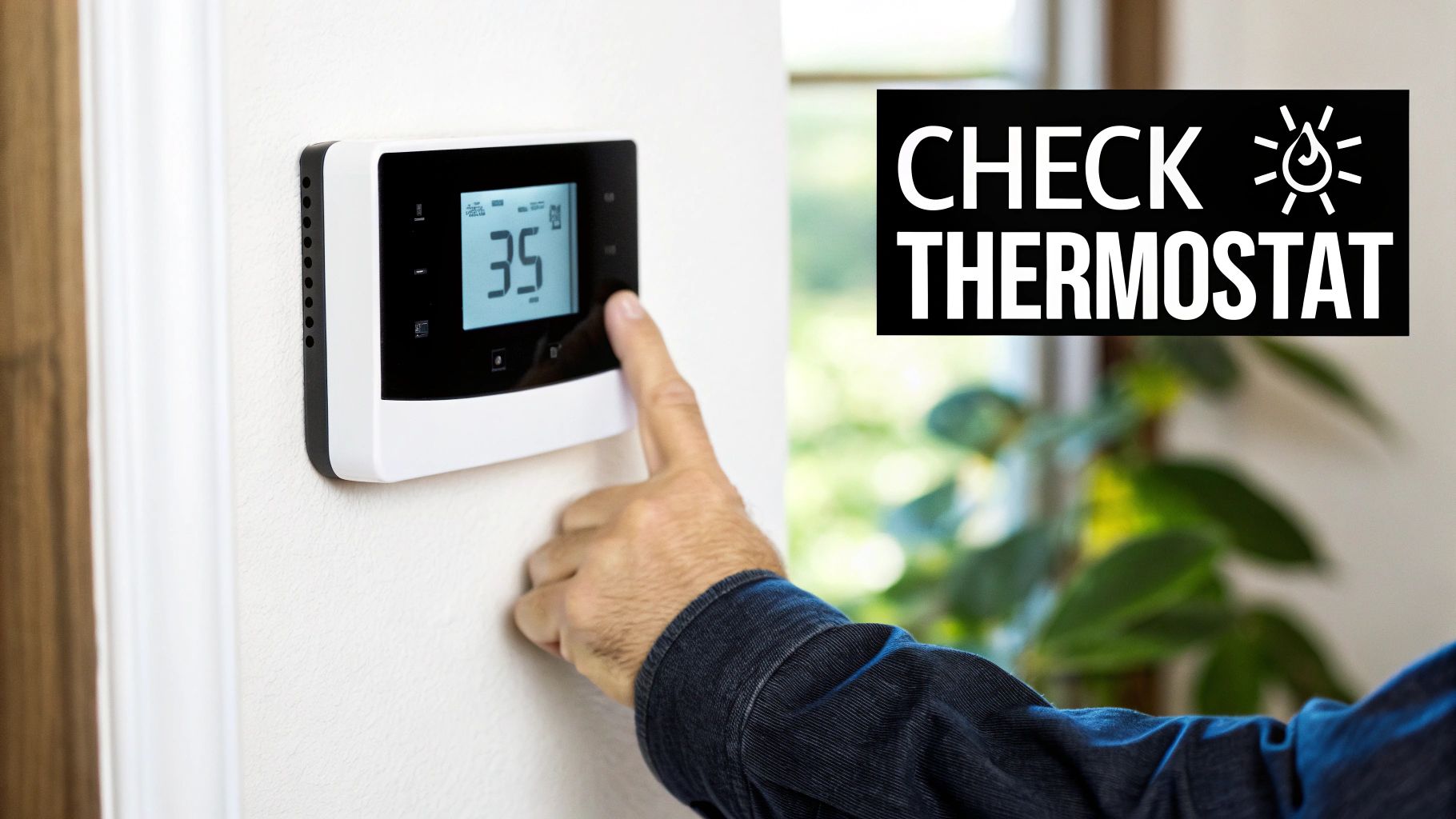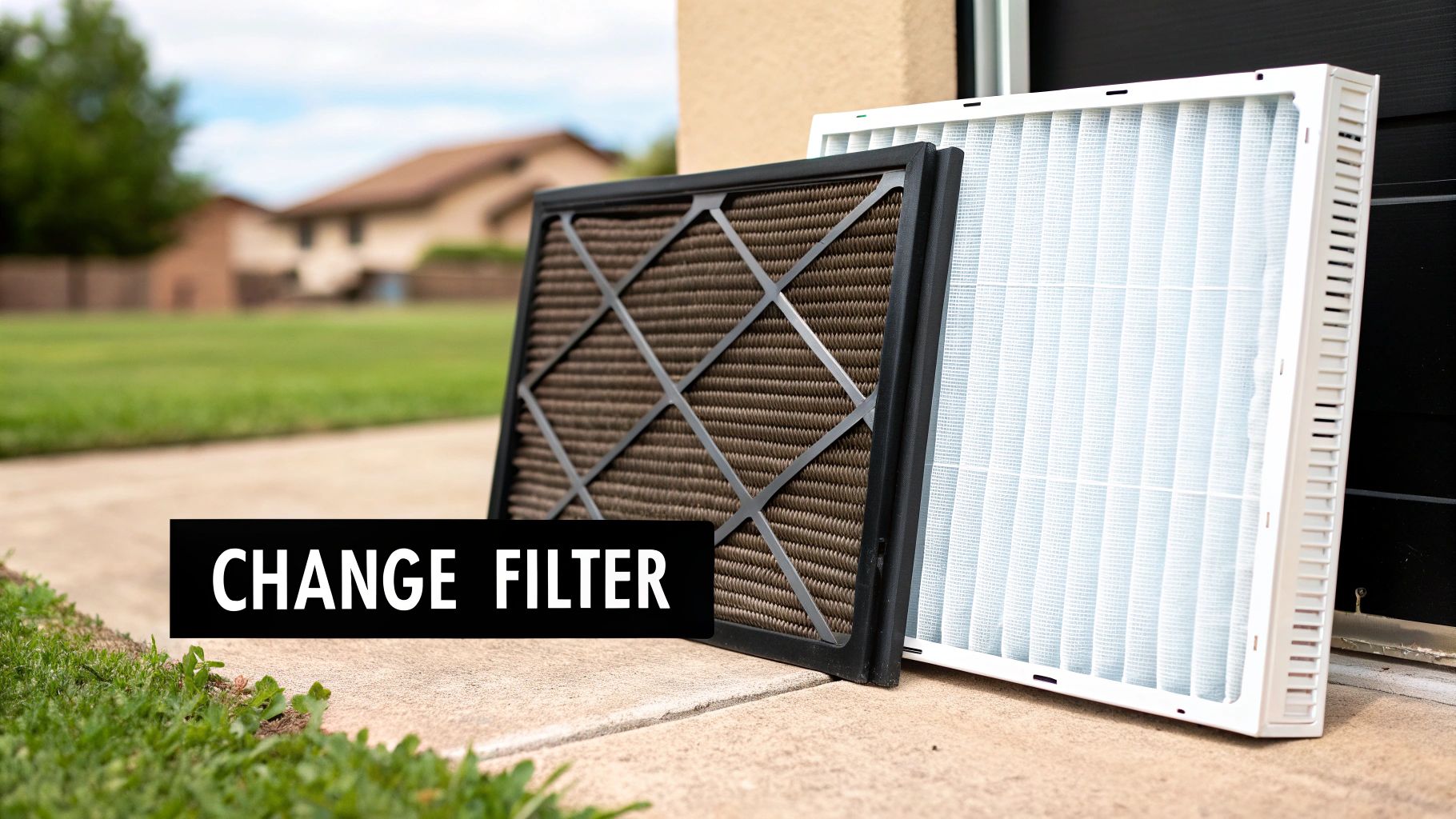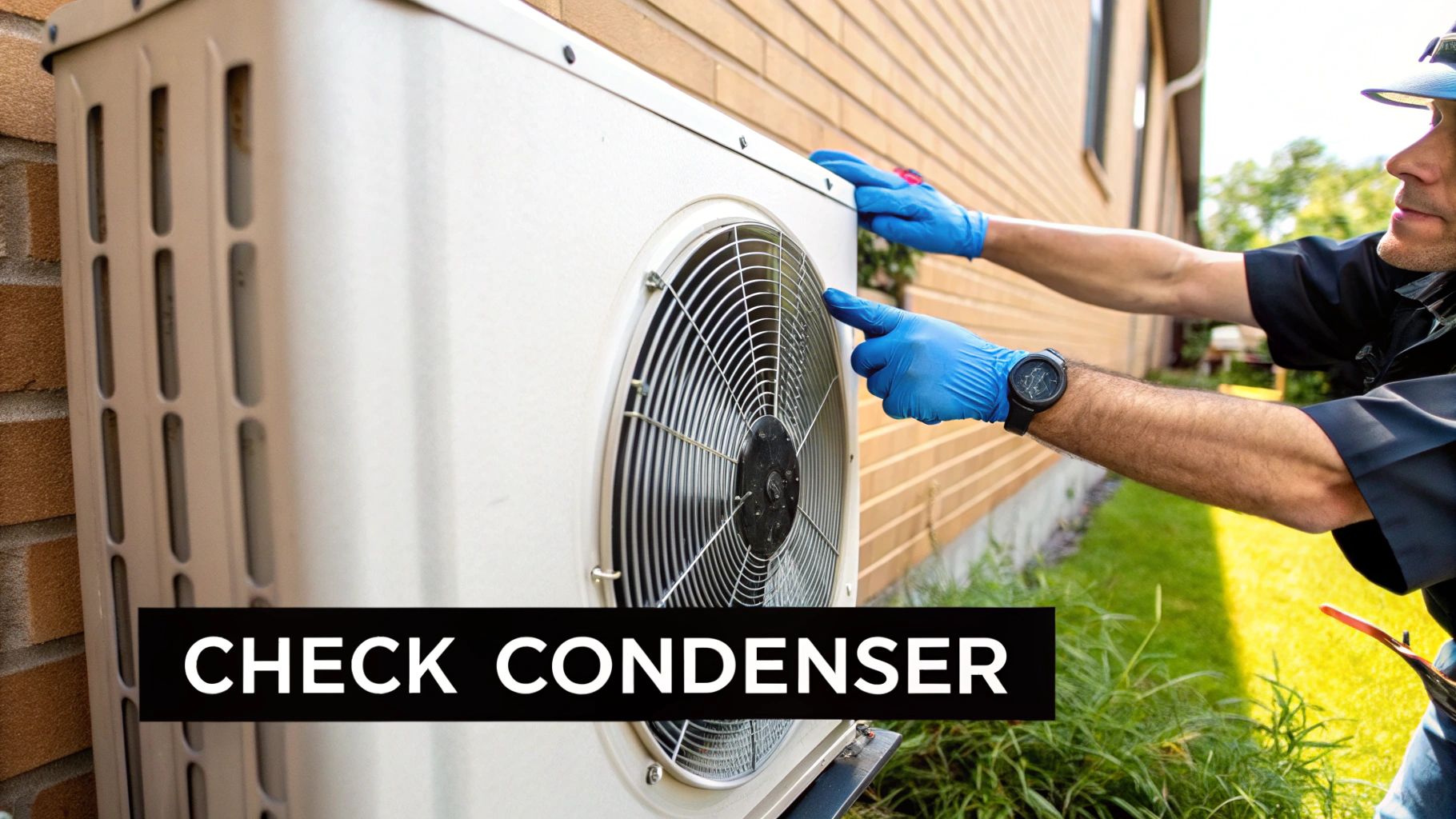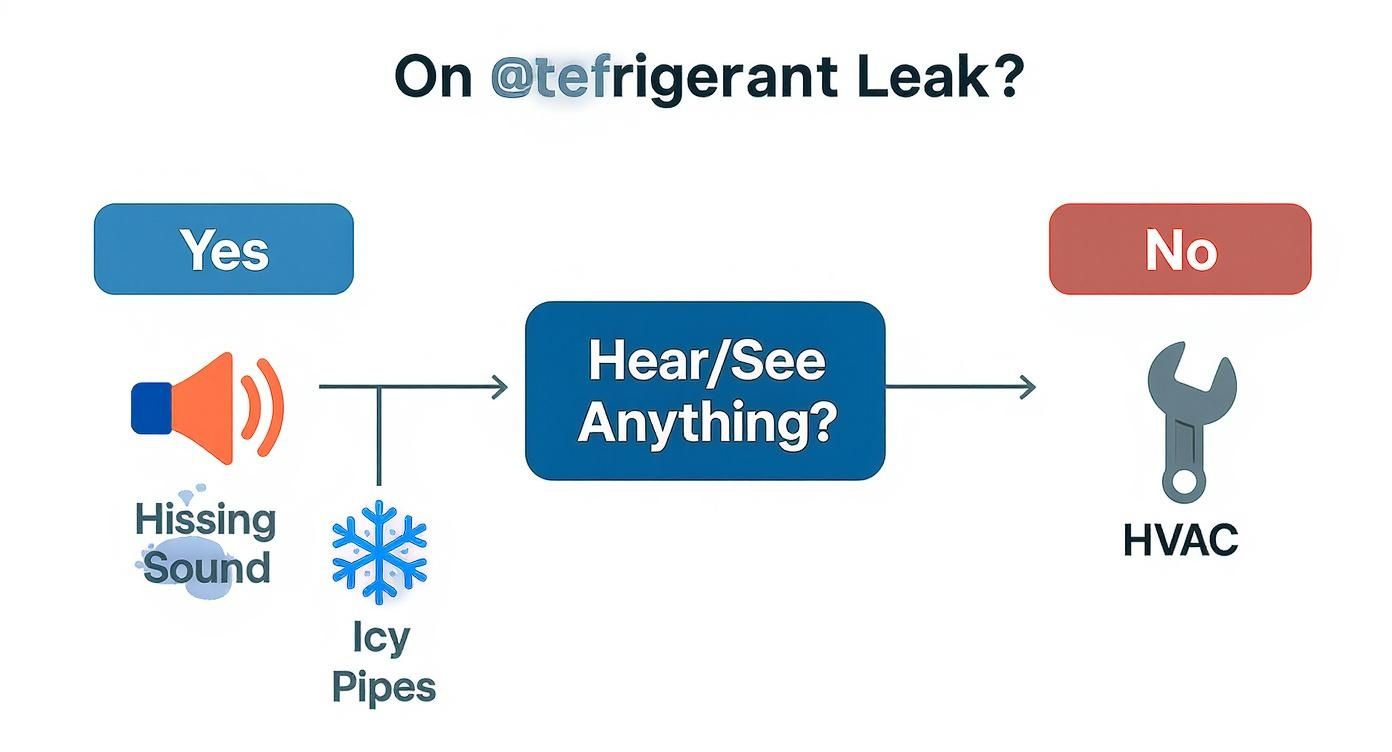air conditioner only blows hot air: Quick DIY Fix Guide
- shawncovenantaire
- 13 minutes ago
- 11 min read
Nothing sends a wave of panic through a homeowner quite like warm air puffing out of the AC vents on a blistering hot day. Before your mind jumps to catastrophic failure and a massive repair bill, take a deep breath. More often than not, the culprit is something surprisingly simple, something you can likely fix yourself in just a few minutes.
These first few checks are your best line of defense. They're designed to quickly rule out the most common, simple issues before you even think about calling for help.
What to Check First When Your AC Blows Hot Air

Let's start with the basics. These two spots account for a huge number of service calls we get, and they are easy for any homeowner to check.
Start with Your Thermostat
Your thermostat is the command center for your entire HVAC system. A wrong setting here is one of the most frequent reasons for an AC blowing warm. It's the very first place you should look.
Check the Mode: Make sure the thermostat is set to 'Cool'. It sounds obvious, but it's incredibly easy for this setting to get bumped to 'Heat' or 'Off', especially with kids in the house or after the seasons change.
Verify the Fan Setting: The fan needs to be on 'Auto', not 'On'. If it's set to 'On', the blower fan will run 24/7, even when the air conditioner isn't actively cooling. This means it will push unconditioned, room-temperature air through your vents between cooling cycles, making it feel like your AC has stopped working. For a deeper dive, check out our guide on thermostat fan 'on' or 'auto' settings.
We see this all the time. A customer calls, frustrated that their AC is blowing hot. We walk them through checking the thermostat, and sure enough, the fan is set to 'On'. Switching it back to 'Auto' solves the problem instantly.
Inspect the Circuit Breaker
If the thermostat settings are correct, your next stop is the electrical panel. Your air conditioning system usually has two separate circuit breakers: one for the indoor unit (the air handler) and another for the outdoor unit (the condenser).
If the breaker for the outdoor unit trips, the indoor fan can still run, but it has no cold air to circulate. The result? Warm air from your vents.
Find the breaker labeled for your AC or condenser and check its position. If it’s in the 'Off' position or looks like it's stuck in the middle, flip it firmly to 'Off' and then back to 'On'. If this brings the cool air back, you’re all set. However, if the breaker trips again right away, that's a clear sign of an electrical problem that needs a professional technician.
As demand on our power grids grows, tripped breakers are becoming more common. In fact, the global air conditioner market was valued at about USD 130.17 billion in 2024 and is projected to keep climbing. This growth puts more stress on systems everywhere, making these simple checks more important than ever. You can learn more about the air conditioner market on fortunebusinessinsights.com.
How a Suffocating AC Stops Blowing Cool Air

If your air conditioner is blowing hot air, the problem might be surprisingly simple: it could be suffocating. Proper airflow is the lifeblood of your cooling system. When it can’t breathe, it can’t cool. The two most common chokepoints are a dirty indoor air filter and a blocked outdoor condenser unit.
A clogged filter is the single most frequent culprit I see when an AC system fails to cool. When your filter is packed with dust, pet hair, and other gunk, your system can't pull in enough warm air from your home to run through the cooling process. It’s like trying to run a marathon while breathing through a straw.
The Five-Minute Filter Fix
Checking your air filter is a quick, five-minute task that can deliver immediate results. You'll usually find the filter in the return air duct, which might be in a ceiling, a wall, or right inside the furnace unit itself.
Here’s the quick rundown on how to inspect it:
Find the Filter: Look for the slotted cover where your air filter lives and pop it open.
Pull and Inspect: Slide the old filter out. A new filter is bright white or off-white. If yours is a depressing shade of gray or caked in grime, it’s time for a change.
Swap It Out: Slide a new, clean filter into the slot. Just make sure the airflow arrows on the side of the filter point in the correct direction; that's usually toward the furnace or air handler.
This simple swap can dramatically improve airflow and often resolves the warm air issue right away.
A restricted filter doesn't just block cool air; it can cause your system’s evaporator coils to freeze over completely. When the coils don't get enough warm air passing over them, they get too cold and ice up, creating a solid block that halts the cooling process entirely.
Give Your Outdoor Unit Some Breathing Room
It’s not just the indoor unit that needs to breathe. Your outdoor condenser, the big fan unit outside, is responsible for dumping all the heat your AC has removed from your home. If it can’t get rid of that heat, it just gets trapped in the system.
This unit needs at least two feet of clear space around it on all sides to work correctly. Things like overgrown shrubs, tall grass, piles of leaves, or even patio furniture parked too close can smother the unit. This causes it to overheat and stop cooling effectively.
Taking a few minutes to clear away any debris can make a massive difference. For a more detailed walkthrough on sprucing up your system, check out our homeowner's guide to air conditioner cleaning.
Time to Check Your Outdoor Condenser Unit

If your AC has suddenly decided to pump out hot air, the problem often starts with the outdoor unit. That big, boxy fan outside is called the condenser, and its whole job is to dump all the heat it pulled from inside your house. When it can't do its job, that heat has nowhere else to go but right back where it came from.
Your first diagnostic tool is simple: your ears. A healthy condenser makes a steady, familiar humming sound, along with the whirring of the big fan. Anything else is a definite red flag.
A loud grinding or squealing, for instance, could mean the fan motor is on its last legs. Or if you hear a distinct buzz but the fan blades aren't moving at all, you're likely looking at a bad capacitor. This is a small, inexpensive part that gives the motor the jolt it needs to get spinning.
Common Outdoor Unit Symptoms
Pinpointing the exact symptom can help a technician figure out the problem much faster if you end up needing to call one. Here’s what you should look and listen for:
Dead Silence: If the unit is making no sound and the fan is still, it's almost certainly a power issue. Double-check the circuit breaker inside, and then look for the outdoor disconnect switch. It's usually a small metal box mounted on the wall right next to the condenser.
Humming, But No Spinning: When you can hear the unit trying to work but the fan won't start, a bad capacitor is the number one culprit. Whatever you do, do not try to push the fan blades to get them started. It’s incredibly dangerous.
Loud, Alarming Noises: Any grinding, clanking, or screeching sounds are bad news. These point to serious mechanical failures inside the compressor or with the fan motor itself and mean it's time to shut the system off and call a pro.
These outdoor units take a real beating, especially in hot climates. In fact, things like fan motor failures and clogged condenser coils are some of the most common technical faults we see causing an AC to blow hot air. For a detailed guide on keeping it clean, you can learn how to clean your condenser coils.
A faulty capacitor is easily one of the top five repairs we perform every summer. It’s a relatively quick and affordable fix for a professional, but it completely stops the cooling process, making it a frustrating problem for homeowners.
This kind of wear and tear is a global issue. The Asia Pacific region, for example, accounted for 57.4% of the air conditioning market revenue in 2024, driven by high temperatures that put constant strain on these systems. You can read more about the global air conditioning market on grandviewresearch.com.
So, you've checked the easy stuff and your AC is still blasting hot air. This is where we start looking at more serious culprits, and a refrigerant leak is high on that list. Refrigerant is the lifeblood of your AC system; it’s the special compound that pulls heat out of your house and dumps it outside. When you're low on it, your AC's cooling ability is completely crippled.
A leak isn't something that will just fix itself, in fact, it's guaranteed to get worse. Putting it off can turn a manageable repair into a catastrophic one, like a fried compressor, which is a much bigger and more expensive headache.
Telltale Signs of a Refrigerant Problem
Catching a refrigerant leak early can be the difference between a simple repair and a total system failure. Now, this isn't a DIY job by any stretch, but knowing what to look for helps you make an informed call to a pro.
Keep an eye (and an ear) out for these classic signs you're dealing with a leak:
Hissing or Bubbling Noises: That distinct hissing sound from either your indoor or outdoor unit? That's often the literal sound of refrigerant gas escaping through a crack in a line or coil. Sometimes it might sound more like a gurgling or bubbling.
Ice on Refrigerant Lines: Take a look at the copper lines running to your big outdoor condenser unit. If you see frost or a solid chunk of ice building up, that's a major red flag. When refrigerant levels drop, the pressure inside the evaporator coil plummets, causing it to get way too cold and freeze the moisture right out of the air.
Sudden Drop in Cooling: If the AC was chugging along just fine yesterday but today it can barely cool a single room, a sudden leak is a likely suspect. The system just doesn't have enough juice to do its job anymore.
The HVAC industry is always pushing for more reliable systems. Innovation often targets common failures like refrigerant loss, which is behind about 35% of all system breakdowns. It's a huge focus, with over 521,200 patents filed globally for air conditioning tech, all aiming to prevent problems like an air conditioner blowing hot air. Despite all that, leaks are still a very common issue we see in the field. You can read more about HVAC innovation on startus-insights.com.
Important Safety Note: Refrigerant is a regulated chemical that has to be handled by a licensed professional. Never, ever try to "top off" or fix a leak yourself. It's dangerous, illegal in many cases, and you could cause even more damage to your system. If you want to learn more about the different types of refrigerants, check out our complete guide on what refrigerant replaces R22.
Knowing When to Call an HVAC Professional
Look, I'm all for rolling up your sleeves and tackling a home project. But when it comes to HVAC systems, you have to know where to draw the line. Getting this wrong can turn a simple fix into a dangerous situation or a repair bill that’ll make your eyes water. Some problems just aren't meant for a DIY approach; they require specialized tools, training, and the right certifications to handle safely.
Electrical work is the big one. If you’ve already tried resetting the breaker and the power problems won’t quit, the issue is buried deeper in the system. Components like the compressor or the capacitor can hold a serious electrical charge, even when the power is completely off. Trust me, you don’t want to mess with these unless you're a trained professional.
The same goes for anything involving refrigerant. That's a non-negotiable, call-a-pro situation. The chemicals are heavily regulated, and you legally need an EPA certification to handle them. Finding and fixing a leak, then recharging the system, has to be done by a licensed technician. There’s no getting around it.
Drawing the Line Between DIY and a Service Call
It’s one thing to change a filter, but it's another to ignore symptoms that are screaming for professional help. Putting off that call can lead to a full-blown system breakdown.
If you notice any of these, it's time to pick up the phone:
Persistent Electrical Issues: Is your circuit breaker for the AC tripping over and over? That’s not a fluke; it's a clear sign of an electrical fault that needs an expert to diagnose.
Loud, Mechanical Noises: Grinding, squealing, or banging sounds coming from your outdoor unit are never good news. This usually points to a failing motor or compressor, which are complex and expensive parts to handle.
Signs of a Refrigerant Leak: As we’ve talked about, hissing sounds or a layer of ice on the copper lines are tell-tale signs of a refrigerant leak. Only a certified tech can legally and safely fix this.
This decision tree gives you a quick visual on when to call for help, especially with refrigerant issues.

The takeaway here is simple: if you see or hear signs of a leak, it's pro time. If your air conditioner only blows hot air and you just can't pinpoint the cause, it's always smarter, and safer, to get an expert opinion. Sometimes, constant breakdowns are also one of the key signs you may need to replace your air conditioner instead of pouring more money into repairs.
On the other hand, if you've checked all the basic AC components and suspect the problem is with your home's main power supply to the unit, it might be time to contact a local electrician. They can trace issues starting from your home's wiring or main panel that might be affecting your AC.
Frequently Asked AC Questions
Even after checking the usual suspects, you probably still have a few questions about why your AC is blowing hot air. It’s a frustrating problem, and we get these calls all the time. Here are some of the most common questions we hear from homeowners.
Why Did My AC Suddenly Start Blowing Hot Air?
When cool air abruptly turns hot, it almost always points to a sudden failure. The first thing to check is the circuit breaker for your outdoor unit. If it's tripped, it cuts all power to the condenser, and the cooling process stops instantly. Your indoor fan, however, will keep running and just circulate the warm air that's already in your house.
Another common culprit is a failed capacitor in the outdoor unit. This little component is what gives the fan motor the kick it needs to start spinning. When it dies, the fan won't turn on, causing the unit to overheat and stop cooling almost immediately.
Can a Dirty Filter Really Cause Hot Air?
You bet it can. It might seem like a simple piece of cardboard and mesh, but a severely clogged air filter can completely bring your AC's cooling power to a halt. It essentially suffocates the system, blocking it from pulling in enough warm air from your home to run over the evaporator coils.
When this happens, the coils don't get the airflow they need, causing them to get way too cold and freeze over. Once they're caked in ice, they can't absorb any heat from the air. Your system is still running, but it's just pushing room-temperature air around. This is one of the top reasons we get service calls, and it's completely preventable with regular filter changes.
A good rule of thumb is to check your filter every month and replace it at least every three months. If you have pets or family members with allergies, you’ll want to change it more frequently, often monthly, to keep your air flowing and your system healthy.
For a deeper dive into how central air systems work and the different options available, this Heat Pump Vs AC: A Central Air Guide is a really helpful resource.
How Long Should I Run the Fan to Thaw Frozen Coils?
If you've discovered a block of ice on your evaporator coils, the first step is to turn the cooling function of your AC off right away. Next, switch your thermostat's fan setting from 'Auto' to 'On'. Don't skip this part!
Forcing room-temperature air to constantly blow over the ice will speed up the thawing process. Depending on how thick the ice is, this can take anywhere from a few hours to a full 24 hours. Be patient and don't turn the cooling back on until every last bit of ice has melted, otherwise, it’s just going to freeze right back up again.
When DIY fixes aren't enough to solve your cooling problems, it's time to call in the experts. For reliable, honest, and professional HVAC service in the Tucson area, trust Covenant Aire Solutions to restore comfort to your home. Schedule your service call today!

